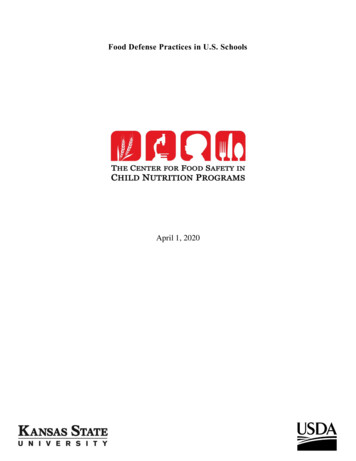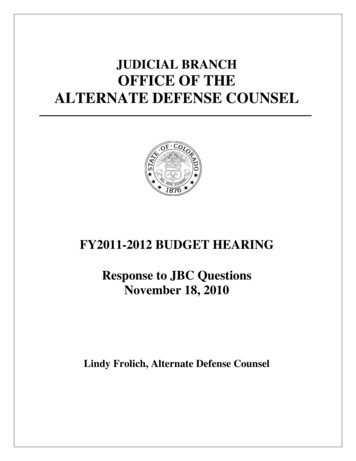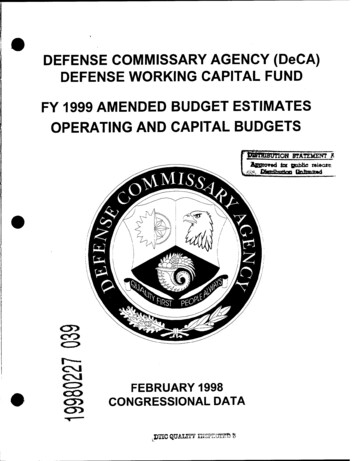
Transcription
Food Defense Practices in U.S. SchoolsApril 1, 2020
Food Defense Practices in U.S. SchoolsSummary ReportThe Center for Food Safety in Child Nutrition ProgramsDepartment of Hospitality ManagementDepartment of Food, Nutrition, Dietetics, and HealthKansas State UniversityKevin R. Roberts, PhDCo-Director & Associate ProfessorKevin Sauer, PhD, RDN, LDCo-Director & Associate ProfessorPaola Paez, PhDResearch Associate ProfessorKerri B. ColeProject CoordinatorCarol Shanklin, PhD, RDProfessor and Dean of the Graduate SchoolFood Defense Practices in U.S. SchoolsP a g e ii
Table of ContentsList of Tables .vExecutive Summary . viAcknowledgements . viiBackground .1Summary of Previous Research .2Objectives .3Methods .4Structured Interview Guide Development .5Research Approval .7Sample Selection and Recruitment .7Data Analysis .9Results and Discussion .9Response rate and sample description .9General Facilities and Personnel Security . 11Foodservice Areas . 12Food and Supplies . 18External Purchases . 19Intra-School Deliveries . 22Personnel Training . 24Food Defense Plan . 26Responding to an Incident . 26Food Defense Practices in U.S. SchoolsP a g e iii
Level of Confidence . 27Conclusions and Recommendations . 29Conclusions . 29Recommendations . 30References . 32Appendix A: Food Defense Questionnaire. 35Appendix B: Invitation Email and Invitation Letter . 57Appendix C: Calendar Invitation, Additional Information, and Scales . 60Appendix D: Interview Reminder . 64Appendix E: Thank You Note and a Copy of Creating Your School Food Defense Plan. 66Appendix F: Follow-up Phone Script and Email Template . 86Food Defense Practices in U.S. SchoolsP a g e iv
List of TablesTable 1. Respondent Demographics (N 320) . 10Table 2. District and School Nutrition Program Demographics (N 320) . 11Table 3. General Facilities and Personnel Security (N 320) . 13Table 4. Foodservice Area Security (N 320) . 14Table 5. Monitoring of Foodservice Areas (N 320) . 16Table 6. Surveillance Camera Information: Frequency of Review & Who has Access (n 255). 17Table 7. Monitoring Methods for Foodservice Areas (N 320). 18Table 8. Food & Supplies (N 320) . 20Table 9. Who has Access to Food Storage Areas (N 320) . 20Table 10. Purchases from Vendors (N 320) . 21Table 11. Intra-school Deliveries (N 320) . 23Table 12. Personnel Training (N 320) . 25Table 13. Respondents’ Level of Confidence in their Food Defense Program . 28Food Defense Practices in U.S. SchoolsPage v
Executive SummaryFood defense plans in Child Nutrition Programs are not required by the United StatesDepartment of Agriculture, but are recommended to support a comprehensive food protectionprogram. Food defense resources specific to schools have been developed by variousgovernment agencies and have been widely available to school nutrition program operators. Yet,anecdotal evidence suggests that food defense program implementation in schools is limited andunderstanding of such programs is unclear among professionals in the field.The research related to food defense within the school environment is not substantial orconsistent but has generally sought to determine areas of potential risk, identify practicesimplemented, and assess preparedness against intentional contamination. The findings of theavailable research are similar, with most practitioners having little concern for food terrorism ortampering in regard to current production systems.The goal of this project was to comprehensively investigate existing practices to preventdeliberate or intentional acts of contamination or tampering in school nutrition programs. Astructured telephone interview, guided by a questionnaire, was used to gather informationconcerning food defense practices from a national sample of school nutrition directors.Results suggest that many school nutrition programs have room to improve food defenseprograms, practices, and the core understanding about food defense in their districts. However,many of the school nutrition programs have indirectly implemented components of a fooddefense plan as part of their overall HACCP-based food safety program. While the opportunityfor improvement is evident in several areas, fundamental practices to prevent an intentional fooddefense incident were strong. Training was lacking across the sample and many respondentsviewed food safety and food defense as one-in-the-same topic.Food Defense Practices in U.S. SchoolsP a g e vi
AcknowledgementsThis study was conducted by the Center for Food Safety in Child Nutrition Programswith federal funds from the U.S. Department of Agriculture. The contents of this publication donot necessarily reflect the views or policies of the U.S. Department of Agriculture, nor doesmention of trade names, commercial products, or organizations imply endorsement by the U.S.government. The researchers thank the U.S. Department of Agriculture Food and NutritionService Regional Offices for their collaboration with sample recruitment and all the schooldistrict personnel that took part in the study.Food Defense Practices in U.S. SchoolsP a g e vii
BackgroundFood defense describes the protection of the nation’s food supply from deliberate orintentional acts of contamination or tampering (United States Department of Agriculture FoodSafety and Inspection Service, 2017). The actual number of said incidents is considered low,although the few cases of deliberate food contamination are well-documented (Anderson,DeMent, Banez, & Hunt, 2011; Brainard & Hunter, 2016; Buchholz et al., 2002; Centers forDisease Control and Prevention, 1989, 2003; Kolavic et al., 1997; Török, 1997). Even though thenumber of incidents is low, concerns about intentional contamination increased after the eventsof September 11, 2001.Although food defense is an important part of a comprehensive food protection programfor school nutrition operations, a formal food defense plan is not required in the school nutritionenvironment. More specifically, current food safety plans focus on accidental biological,chemical, and physical hazards. However, the United States Department of Agriculture (USDA)Food and Nutrition Service (FNS) recommends that Child Nutrition Programs develop a fooddefense plan (USDA FNS, 2007; USDA FNS, 2012). A comprehensive food defense plan inschools is multifaceted, encompassing many internal and external stakeholders. Stakeholderswithin the school district include the school nutrition team, maintenance and security staff, andboth administrative and instructional staff. External stakeholders include local and state police,fire fighters, vendors, and state agencies related to safety, security, and child nutrition.Resources specific to food defense training in schools have been developed by variousgovernment agencies and have been widely available to school nutrition program operators. TheUnited States Department of Education Emergency Response and Crisis Management TechnicalAssistance Center has published Food Safety and Food Defense for SchoolsFood Defense Practices in U.S. SchoolsPage 1
.pdf). The USDA FNS published CreatingYour School Food Defense Plan /ofs/Food Safety Creating Food Defense Plan.pdf) and ABiosecurity Checklist for School Foodservice Programs: Developing a Biosecurity ManagementPlan (https://www.hsdl.org/?view&did 463416). The Institute of Child Nutrition offers atabletop food defense exercise for schools (https://theicn.org/?s food defense).Summary of Previous ResearchThe majority of the research related to food defense programs within the schoolenvironment sought to determine areas of potential risk, identify practices implemented, andassess preparedness against intentional contamination. While different settings have beenexamined, findings were similar. Common research methods included surveys (mail and online),interviews, focus groups, observations, and analysis of documents.When food defense plans were assessed, most studies found low concern for foodterrorism or tampering and foodservice operators expressed little risk with current productionsystems (Klitzke et al., 2016; Klitzke, Strohbehn, & Arendt, 2014; Olds & Shanklin, 2014;Xirasagar et al., 2010b). The greatest perceived risk for intentional food contamination was withthe supply chain prior to arrival at the foodservice operation (Klitzke et al., 2014; Klitzke et al.,2016). Areas for a potential attack identified for foodservice operations were unidentified staffand/or delivery personnel and access to cafeteria, central kitchens, service lines, storage areas,and delivery areas (Klitzke et al., 2016; Olds & Shanklin, 2014).When practices were assessed, the least implemented practices were locked storage anddelivery areas, secured chemicals, reviewing employees’ criminal backgrounds, surveillancesystems in place, communication with vendors/suppliers, delivery schedules posted withFood Defense Practices in U.S. SchoolsPage 2
information related to delivery personnel, and secured access (Olds & Shanklin, 2014; Story,Sneed, Oakley, & Stretch, 2007; Xirasagar et al., 2010b). In contrast, the most implementedpractices were having an emergency response team, purchasing of food and supplies from areputable supplier with permits and licenses, inspection of food packages, restricted access toproduction and storage areas, chemical use, and food storage (Story et al., 2007; Strohbehn &Klitzke, 2015; Yoon & Shanklin, 2007a, 2007b, 2007c).Strohbehn and Klitzke (2015) noted that only 14% (78 of 543) of school nutritionprograms reported having a food defense plan. Barriers to implementing a food defense planincluded: lack of awareness and concern related to food terrorism, lack of motivation, cost, andthe perception that food defense is solely the foodservice director’s responsibility (Klitze et al.,2014; Klitze et al., 2016; Olds & Shanklin, 2014). Operations were more likely to have a fooddefense plan or perform food defense practices if operators perceived food defense practices asimportant (Yoon & Shanklin, 2007a), a designated employee was assigned to implement ormonitor food defense practices (Yoon & Shanklin, 2007b), and/or employees had received fooddefense training (Strohbehn & Klizke, 2015).ObjectivesThe goal of this project was to investigate existing practices to prevent deliberate orintentional acts of contamination or tampering in school nutrition programs.Specific Objectives included:1. Identify current practices to prevent deliberate or intentional acts of contamination ortampering in school nutrition programs.Food Defense Practices in U.S. SchoolsPage 3
2. Assess deficiencies in practices to prevent deliberate or intentional acts of foodcontamination or tampering in school nutrition programs.3. Provide evidence-based recommendations for education and training resources.MethodsA structured telephone interview, guided by a questionnaire, was used to gatherinformation concerning food defense practices from a national sample of school nutritiondirectors. The rationale for using an interview format for data collection was due to sharedconcerns that questions about food defense, presented via an online or paper survey instrument,would be perceived as one-and-the-same as typical food safety beliefs or internal efforts. Thus,interviews were conducted to clarify and discern as true as possible beliefs about food defense,on an individual basis, that were distinct from common food safety measures. The data latersuggested that this concern (confusion about food safety vs. food defense) was in fact justified,and that interviews provided the necessary clarity about the aims of the study and questions athand.The staff at the Center for Food Safety in Child Nutrition Programs (the Center) and theUSDA FNS Office of Food Safety (OFS) collaborated on the development of the questionnaire.The questions were designed and categorized to address the study objectives, with bothquantitative and qualitative data gathered and analyzed. Figure 1 illustrates the methods utilized.Food Defense Practices in U.S. SchoolsPage 4
Literature ReviewStructuredInterview GuideDevelopment &Research ApprovalSample Selectionand RecruitmentData AnalysisPilot TestData Collection:Interviews SPSS Qualitative analysisFigure 1. Methods: Food defense practices in school nutrition programsStructured Interview Guide DevelopmentInstrument development began with an in-depth literature review. The USDAFNS (2010) Food Defense Plan was used as a reference to develop a master list of questions.This was then compared to eight other instruments that were developed to explore food defensein foodservice operations (Department of Health and Human Services, US Food and DrugAdministration, and Center for Food Safety and Applied Nutrition, 2001; Klitzke et al., 2016;Olds & Shanklin, 2014; Strohbehn, Sneed, Paez, & Beattie, 2007; USDA Food Safety andInspection Services, 2016; USDA FNS, 2007; USDA FNS, 2012; Xirasagar, Kanwat, Smith, Li,Sros, & Schewchuk, 2010a; Yoon & Shanklin, 2007a). The research team categorized andreviewed each question. Redundant questions, questions about items not under the control of theschool food authority (SFA), or questions related to food safety and not food defense wereremoved from the questionnaire. Probing questions were included to obtain more detailedresponses about both school districts as a whole and school nutrition programs. The final set ofFood Defense Practices in U.S. SchoolsPage 5
questions was then entered into Qualtrics , an online survey and data management system, fordata collection.The instrument was developed in an online format and was intended to be used for theresearcher to scribe and collect data via telephone. Because this was an unconventionalapproach, the research team reviewed and practiced the survey delivery multiple times, both inperson and via remote video conference, as to emulate the actual data collection phase. A teammember read each question from a satellite location to the other researchers, and changes weremade to the survey to improve clarity and delivery.Two pilot tests were conducted on the instrument. For the first pilot test, 28 randomlyselected districts, two from each state chosen for the main study, were selected and contacted viaemail to request participation. An email reminder was sent after one week if no response wasreceived. A week later, phone calls were made to each SFA selected. Of these, only twocompleted the interview. Due to the low response rate, a second pilot test was conducted, and 52school districts were selected from a randomly selected state not included in the sample. Thispilot test yielded an additional seven responses, for a total of nine responses in the pilot test. Thepilot test resulted in minor changes to the questionnaire, and the methodology for the main studywas revised: rather than contacting SFAs twice via email before following up with a phone call,the main study utilized a recruitment email, followed-up with a phone call, and a final email.The final instrument included 10 sections: general facilities and personnel security,foodservice areas, food and supplies, external vendors, internal systems, water and ice supply,personnel training, food defense plan, suppliers, and general information about the schoolnutrition program and demographic information about the interviewee (see Appendix A). In thegeneral facilities and personnel security section, participants were asked to refer to district-wideFood Defense Practices in U.S. SchoolsPage 6
practices when responding to the questions. The sections that included questions specific to theschool nutrition program, participants were asked to respond to these questions for the schoolnutrition program as a whole.Research ApprovalKansas State University’s Institutional Review Board approved the research protocolbefore data were collected. All researchers involved in the study successfully completedmandatory human subjects training.Sample Selection and RecruitmentTo ensure a representative sample was selected among districts across the United States,two states from each of the seven USDA FNS regions were randomly selected for a total of 14states. For each of the states selected, a list of all districts was download from the NationalCenter for Education Statistics website (https://nces.ed.gov/ccd/districtsearch/). Based onprevious studies (Basem, Roberts, Lin, & Sauer, 2019; Grisamore & Roberts, 2014; Roberts,Sauer, Paez, Shanklin, & Alcorn, 2018) that yielded a response rate of 10% to 14%, the goal wasto select 145 districts from each state to achieve a minimum sample size of 280 districts (20districts per state). Districts were then categorized by student enrollment (mega 40,000students, large 20,000 to 39,999 students, medium 2,500 to 19,999 students, and small 2,500 students). In order to assure districts of all sizes were included, and because there are onlya few mega and large districts in each state, all mega and large school districts were invited toparticipate. The remaining number to total 145 were randomly selected, but divided equallybetween medium and small districts. In the instance a state had less than 145 school districts, alldistricts were invited to participate.Food Defense Practices in U.S. SchoolsPage 7
Contact information for the SFA in each district was obtained from USDA FNS RegionalOffices with cooperation from the OFS. A random number generator was utilized to assign eachschool district on the National Center for Education Statistics list a number and then districtswere sorted from lowest to highest based on this number. The number of districts needed toreach the sample size of 145 were selected from the top of the list. Contact information was thencross referenced on the list provided by USDA and any contact information not included on theUSDA list was obtained from the website of the school district.Data collection for each of the 14 states was staggered by approximately one week toallow time for researchers to conduct follow-up phone calls and interviews. An initial invitationwas sent via email to the SFA with a letter explaining the purpose of the project (Appendix B).Once the SFA agreed to participate, a calendar invitation was sent with additional informationand the scales to be used (Appendix C). A reminder was sent the day before the scheduledinterview, and the scales to be used during the interview were again included (Appendix D). Athank you note and a copy of Creating your School Food Defense Plan guidance (USDA, 2012)was sent to each SFA that completed the interview (Appendix E). If an SFA declined toparticipate, they were immediately removed from the sample.Approximately 7 to 10 days after the initial email, an attempt was made to contact eachSFA who had not responded to the initial email via telephone to solicit their participation. Thephone contact script is presented in Appendix F. Due to time constraints, only an average of22% (SD 12.5%) were contacted via phone. Two weeks after the initial email, any SFA whohad not yet replied was sent a follow-up email (Appendix F). Recruiting telephone calls to theSFAs ceased once the desired number of respondents from each state was achieved, while thefollow-up email was sent to all SFAs who had not yet responded.Food Defense Practices in U.S. SchoolsPage 8
Data AnalysisThe raw data set was imported from the Qualtrics survey system into SPSS. SPSS wasutilized to run descriptive statistics including frequencies, percentages, and means. Summariesof specific comments or key themes were derived from the open-ended responses.Results and DiscussionResponse rate and sample descriptionA total of 320 interviews were planned and completed, representing 15% of the sample.Interviews averaged 33 minutes and ranged from 18 minutes to 86 minutes. While the responserate was low, it is similar to response rates for other research projects with a similar sample inrecent years (Basem, Roberts, Lin, & Sauer, 2019; Grisamore & Roberts, 2014; Roberts, Sauer,Paez, Shanklin, & Alcorn, 2018). The lower response rate could also be a result of the surveybeing conducted via telephone interview late in the academic year. Figure 2 presents the numberof school districts included in the sample from each of the seven USDA FNS regions as of thedate the sample was selected (Fall 2018).MPRO(n 47)MWRO(n 36)NERO(n 47)MARO (n 40)WRO (n 56)SERO (n 50)SWRO (n 44)Figure 2. Number of School Districts Included in the Sample from each USDA FNS Region.Food Defense Practices in U.S. SchoolsPage 9
Demographics of the respondents are presented in Table 1. The majority of respondentshave worked in foodservice for more than 20 years (61.9%) and in their current position for morethan four years (67.8%).Table 1. Respondent Demographics (N 320)Respondent DemographicsHow long have you worked in any type of foodservice?Less than 1 year1-3 years4-7 years8-12 years13-20 yearsOver 20 yearsNumber (%)a5 (1.6)5 (1.6)19 (5.9)26 (8.1)64 (20.0)198 (61.9)Years in your current position?Less than 1 year1-3 years4-7 years8-12 years13-20 yearsOver 20 years27 (8.4)73 (22.8)103 (32.2)44 (13.8)40 (12.5)30 (9.4)Have you ever received training about food defense?YesNo150 (46.9)167 (52.2)Title of person(s) interviewedSchool Nutrition Director / General ManagerSchool Nutrition Manager / SupervisorSchool/District Administrative PersonnelSchool Nutrition Coordinator / Head CookSchool Nutrition Administrative AssistantNutrition Specialist / Dietitian247 (80.3)26 (8.1)21 (6.7)13 (4.1)13 (4.1)2 (1%)aPercentages and totals may not equal 320 or 100% due to non-responses.Table 2 presents a description of the district and school nutrition programs in the study.Almost half (46.1%) of the sample reported a district enrollment of 2,500 to 19,999 students,with 32.8% of districts having less than 2,500 students. The majority (50.6%) of the respondentsindicated they had a well-documented crisis management plan.Food Defense Practices in U.S. SchoolsP a g e 10
Table 2. District and School Nutrition Program Demographics (N 320)Number(%)aOperational DemographicsHow many students are enrolled inAverage Number of Lunchesyour district?ServedLess than 2,500 (Small)105 (32.8)Less than 1,0002,500 – 19,999 (Medium)157 (49.1)1,000-4,99920,000 – 39,999 (Large)30 (9.4)5,000-9,99940,000 or more (Mega)25 (7.8)10,000-14,99915,000-19,99920,000 or moreSelf-Operated vs. ContractSelf-operated261 (81.6)Contractor56 (17.5) Number of employees in theSchool Nutrition Program?Less than 10Has your school nutrition programconducted a food defense audit?10 – 24 employeesNo276 (86.3)24 – 25 employeesYes, Internal audit30 (9.4)50 – 74 employeesYes, external audit by75 – 99 employees10 (3.1)government agency100 - 149 employeesYes, external audit by consultingGreater than 1503 (0.9)companyDoes the school nutrition programhave a crisis management plan?NoYes, and it is well documentedYes, but no written documentsaNumber(%)a79 (24.7)144 (45.0)32 (10.0)16 (5.0)14 (4.4)24 (7.5)51 (15.9)58 (18.1)80 (25.0)38 (11.9)13 (4.1)15 (4.7)61 (19.1)109 (31.4)162 (50.6)40 (12.5)Percentages and totals may not equal 320 or 100% due to non-responses.General Facilities and Personnel SecurityTable 3 summarizes the frequency of responses, means, and standard deviations forquestions related to the security of general facilities and personnel within the district-wide schoolenvironment who may have access to the food supply. In most of the interviews, the majority ofrespondents indicated they always follow the practices outlined and in eight of the 10 occasionsthe score was above 4.0, indicating that the majority skewed towards always doing the practiceoutlined. Additionally, 61.6% indicated they never allow vendor access to their facilities afterFood Defense Practices in U.S. SchoolsP a g e 11
hours. In instances where food deliveries are allowed after hours, common products deliveredincluded dairy (23.8%), bread (9.7%), broadline or grocery orders (7.2%), or produce (3.1%).An open-ended question probed what occurs if a foodservice staff member observes anunauthorized person in a restricted area. Twenty-nine of the respondents (9.1%), indicated theydid not know or were not aware what the protocol would be. The most common response (138of 494 responses) was to alert the police, school security, administration, or other school staff.An additional open-ended question probed who ensures that terminated employees loseall means of immediate access to the facility. Of the 320 respondents, 45% indicated theadministration or district office oversees this practice. Other responses included the maintenancedepartment (39.7%), department heads (23.4%), school police or security (21.5%), or otherdistrict departments (human resources, technology, safety, risk management; 27.2%). Seven(2.2%) of the respondents indicated they did not know who monitors this policy.Foodservice AreasTable 4 summarizes the frequency of responses, means, and standard deviations forquestions related to the security of the foodservice areas within the school buildings. All of themeans in this area were above 4.0. For the practice of having an emergency lighting systemwithin the foodservice area, less than 15% of respondents indicated they sometimes, rarely, ornever had this in their district. Greater than two-thirds of all respondents always followed thepractices outlined in this area, with the exception of securing the foodservice area during theschool day to prevent entry by unauthorized persons. Only 58.4% indicated this was alwaysdone. In 7.2% of the districts this was never or rarely done. In 6.9% of the districts, theFood Defense Practices in U.S. SchoolsP a g e 12
Table 3. General Facilities and Personnel Security (N 320)Frequency (%) aSecures the school buildings duringthe school day to prevent entry byunauthorized persons.Accounts for facilit
Food Defense Practices in U.S. Schools P a g e vi Executive Summary Food defense plans in Child Nutrition Programs are not required by the United States Department of Agriculture, but are recommended to support a comprehensive food protection program. Food defense res










